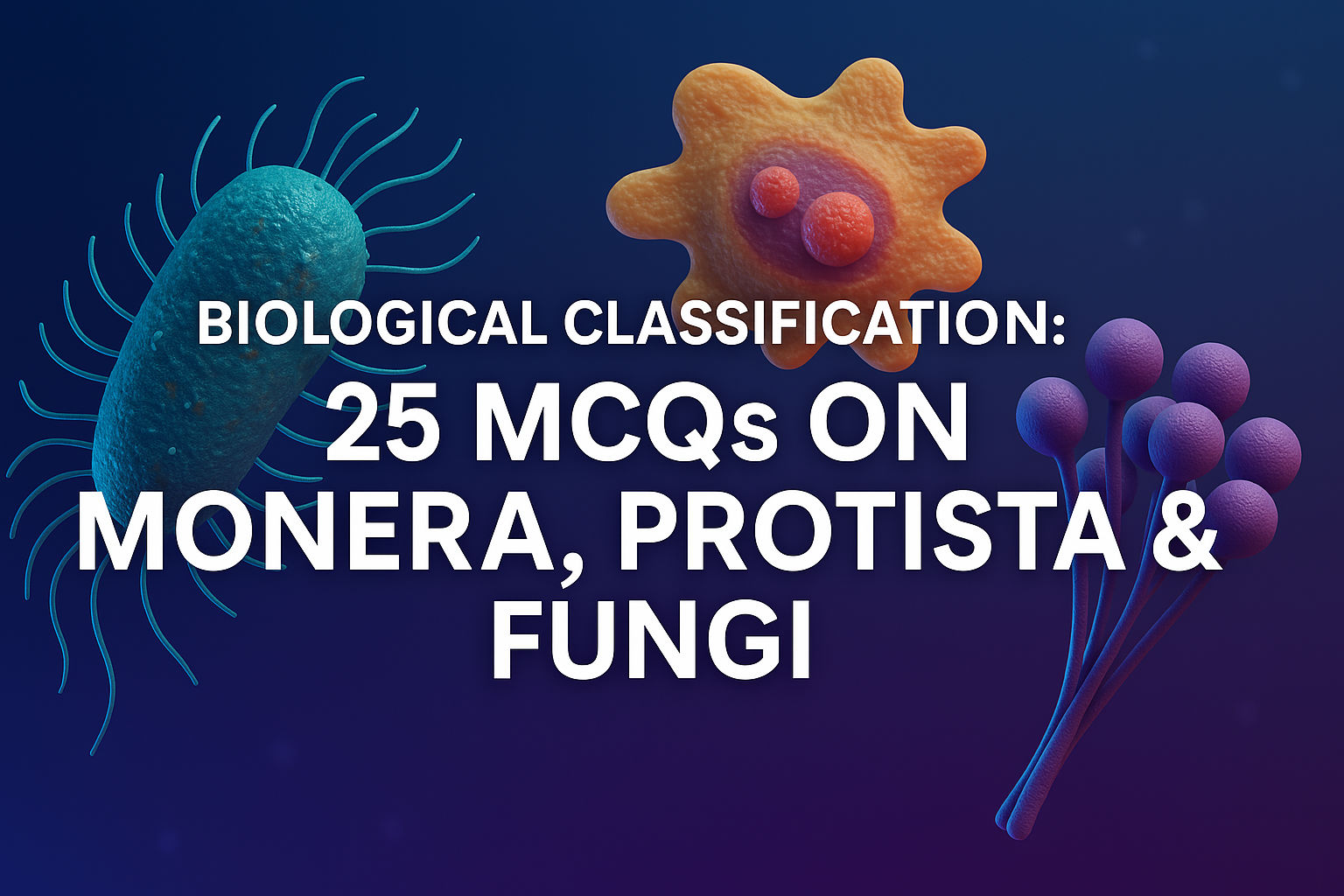Biological Classification: 25 MCQs on Monera, Protista & Fungi
Test your knowledge with 25 multiple-choice questions on Monera, Protista, and Fungi. Ideal for Class 11 student and NEET aspirants preparing for exam
📅 Published on: May 12, 2025
✍️ Author: The Govt Guide

Table of Contents
Kingdom Monera: MCQs 1–10
-
Which of the following is a characteristic of organisms in Kingdom Monera?
a) Multicellular
b) Eukaryotic
c) Prokaryotic
d) None of the above
Answer: c) Prokaryotic -
Which of the following is not a common shape of bacteria in the kingdom Monera?
a) Cocci
b) Bacilli
c) Spirilla
d) Fungi
Answer: d) Fungi -
What is the main mode of nutrition for most Monera species?
a) Heterotrophic
b) Autotrophic
c) Mixotrophic
d) Parasitic
Answer: a) Heterotrophic -
Which of the following are likely to be present in deep seawater?
a) Archaebacteria
b) Blue-green algae
c) Saprophytic fungi
d) Eubacteria
Answer: a) Archaebacteria -
Which of the following bacteria can survive in extreme environmental conditions?
a) Cyanobacteria
b) Eubacteria
c) Archaebacteria
d) Mycobacteria
Answer: c) Archaebacteria -
Which of the following is not a characteristic of cyanobacteria?
a) Photosynthetic
b) Nitrogen-fixing
c) Eukaryotic
d) Prokaryotic
Answer: c) Eukaryotic -
Mycoplasmas are unique among prokaryotes because they:
a) Have a cell wall
b) Lack a cell wall
c) Are multicellular
d) Are photosynthetic
Answer: b) Lack a cell wall -
Which of the following is a nitrogen-fixing bacterium?
a) Rhizobium
b) Escherichia coli
c) Salmonella
d) Mycobacterium
Answer: a) Rhizobium -
Which of the following statements about bacteria is true?
a) All bacteria are harmful
b) Bacteria lack DNA
c) Bacteria are unicellular
d) Bacteria are eukaryotic
Answer: c) Bacteria are unicellular -
Which of the following is not a function of bacteria?
a) Decomposition
b) Nitrogen fixation
c) Photosynthesis
d) Formation of bones
Answer: d) Formation of bones
Kingdom Protista: MCQs 11–17
-
Which of the following is not a characteristic of Kingdom Protista?
a) Unicellular organization
b) Prokaryotic nature
c) Presence of membrane-bound organelles
d) Sexual and asexual reproduction
Answer: b) Prokaryotic nature -
The locomotory organ in Amoeba is:
a) Flagella
b) Cilia
c) Pseudopodia
d) Tentacles
Answer: c) Pseudopodia -
Which of the following groups of Protista includes diatoms?
a) Chrysophytes
b) Dinoflagellates
c) Euglenoids
d) Protozoans
Answer: a) Chrysophytes -
Red tide is caused by:
a) Euglena
b) Gonyaulax
c) Plasmodium
d) Trypanosoma
Answer: b) Gonyaulax -
Which of the following statements is false about dinoflagellates?
a) They have two flagella
b) They are mostly photosynthetic
c) Their cell wall contains silica
d) Some produce bioluminescence
Answer: c) Their cell wall contains silica -
The slime molds are characterized by:
a) Having chitin in cell walls
b) Being prokaryotic
c) Having plasmodial or cellular forms
d) Presence of flagella
Answer: c) Having plasmodial or cellular forms -
The vector for the disease sleeping sickness is:
a) Housefly
b) Anopheles mosquito
c) Tse-tse fly
d) Sand fly
Answer: c) Tse-tse fly
Kingdom Fungi: MCQs 18–25
-
Which of the following is not a characteristic of fungi?
a) Eukaryotic
b) Autotrophic
c) Heterotrophic
d) Cell wall made of chitin
Answer: b) Autotrophic -
Which of the following fungi is used in the production of alcohol?
a) Penicillium
b) Saccharomyces cerevisiae
c) Aspergillus
d) Rhizopus
Answer: b) Saccharomyces cerevisiae -
Mycorrhiza is a symbiotic association between fungi and:
a) Algae
b) Bacteria
c) Plant roots
d) Protozoa
Answer: c) Plant roots -
Which of the following is an edible fungus?
a) Amanita
b) Agaricus
c) Claviceps
d) Puccinia
Answer: b) Agaricus -
Which of the following fungi is used in the production of antibiotics?
a) Penicillium
b) Saccharomyces
c) Rhizopus
d) Aspergillus
Answer: a) Penicillium -
Which of the following is a fungal disease in plants?
a) Rust
b) Blight
c) Wilt
d) All of the above
Answer: d) All of the above -
Which of the following is a unicellular fungus?
a) Rhizopus
b) Penicillium
c) Yeast
d) Aspergillus
Answer: c) Yeast -
Which of the following is a characteristic of Deuteromycetes?
a) Known sexual reproduction
b) Absence of sexual reproduction
c) Presence of flagella
d) Autotrophic nutrition
Answer: b) Absence of sexual reproduction
Join the conversation